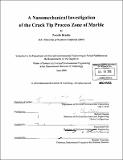| dc.contributor.advisor | Herbert Einstein and Franz-Josef Ulm. | en_US |
| dc.contributor.author | Brooks, Zenzile (Zenzile Z.) | en_US |
| dc.contributor.other | Massachusetts Institute of Technology. Dept. of Civil and Environmental Engineering. | en_US |
| dc.date.accessioned | 2011-01-26T14:26:05Z | |
| dc.date.available | 2011-01-26T14:26:05Z | |
| dc.date.copyright | 2010 | en_US |
| dc.date.issued | 2010 | en_US |
| dc.identifier.uri | http://hdl.handle.net/1721.1/60797 | |
| dc.description | Thesis (S.M.)--Massachusetts Institute of Technology, Dept. of Civil and Environmental Engineering, 2010. | en_US |
| dc.description | Cataloged from PDF version of thesis. | en_US |
| dc.description | Includes bibliographical references (p. 133-140). | en_US |
| dc.description.abstract | This study explores the interaction between crack initiation and nanomechanical properties in the crack tip process zone (zone of microcracking at the tip of a propagating crack) of a brittle geomaterial. Samples of Carrara marble with pre-existing cracks ("flaws") were loaded in a uniaxial testing machine until the process zone appeared at the tips of the pre-existing cracks in form of "white patching". Three techniques were then used to obtain nanomechanical properties of the process zone and relate them to macroscale crack initiation: digital photography, to visually assess the macrostructure and crack formation, environmental scanning electron microscopy (ESEM), to visually assess microstructure, and nanoindentation, to yield nanomechanical properties and assess nano/microheterogeneities. Nanoindentation testing was comprised of lines and grids of single nanoindentations located both near and far from the process zone. The purpose of nanoindentation testing is to investigate the underlying trend in nanomechanical property change between intact and process zone marble. Analysis of nanoindentation testing results showed a decrease of both modulus and hardness (a) near grain boundaries in intact material, and (b) with closeness to the process zone. Ultimately, the study confirms that the crack tip process zone manifests itself as an area of reduced nanomechanical properties in marble. | en_US |
| dc.description.statementofresponsibility | by Zenzile Brooks. | en_US |
| dc.format.extent | 158 p. | en_US |
| dc.language.iso | eng | en_US |
| dc.publisher | Massachusetts Institute of Technology | en_US |
| dc.rights | M.I.T. theses are protected by
copyright. They may be viewed from this source for any purpose, but
reproduction or distribution in any format is prohibited without written
permission. See provided URL for inquiries about permission. | en_US |
| dc.rights.uri | http://dspace.mit.edu/handle/1721.1/7582 | en_US |
| dc.subject | Civil and Environmental Engineering. | en_US |
| dc.title | A nanomechanical investigation of the crack tip process zone of marble | en_US |
| dc.type | Thesis | en_US |
| dc.description.degree | S.M. | en_US |
| dc.contributor.department | Massachusetts Institute of Technology. Department of Civil and Environmental Engineering | |
| dc.identifier.oclc | 695578240 | en_US |
